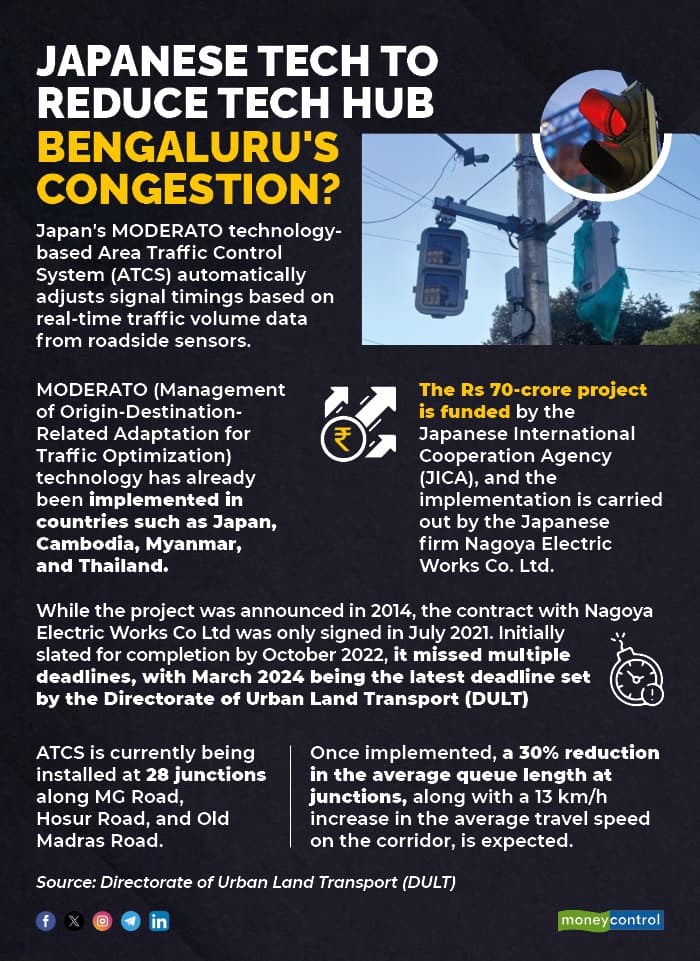



A new traffic signalling system based on the Japanese MODERATO (Management of Origin-Destination-Related Adaptation for Traffic Optimisation) technology has been recently activated at the junction of Kensington Road and Murphy Road near Ulsoor for vehicles and pedestrians.
These traffic signals, in place at 28 major junctions along MG Road, Hosur Road, and Old Madras Road in Bengaluru, have been non-operational for the past few months for a variety of reasons, but will soon be pressed into action. Currently, these junctions have fixed traffic signal timers, regardless of the number of vehicles at the junction. The new system will enable signals to change automatically based on the density of vehicles at each junction.
"The signal at the junction of Kensington Road and Murphy Road has been temporarily turned on (for a week) to check the installation and switching procedures. The actual testing of the signals will begin from the last week of February 2024," Deepa Cholan, Commissioner, Directorate of Urban Land Transport (DULT), which is implementing the project, told Moneycontrol.
Can Japanese tech ease Bengaluru’s notorious traffic snarls?If all goes as per DULT’s plan, all 28 signals in core city areas will be operational by March 2024. The Rs 72-crore project is funded by the Japanese International Cooperation Agency (JICA), and the Japanese firm Nagoya Electric Works Company Limited is implementing it.
"All 28 traffic signals are expected to be commissioned by the end of March 2024, after conducting detailed testing of the system," Cholan said.
"Civil works for the installation of signals and associated sensors are over. The power connection to the signals has been completed, and the power connection to the sensors will be done by the third week of February," she explained.

The project was first announced in 2014 but gained momentum only in July 2021. While it was scheduled for completion by October 2022, it missed multiple deadlines. DULT had set a revised deadline for August 2023, but it failed to resolve power supply issues. In November 2023, DULT issued a short-term tender to provide electrical connectivity for the Queue-Length Measurement System (QLMS), Variable Message Signs (VMS), and Automatic Traffic Counter & Classifier (ATCC) locations as part of the Bengaluru Advanced Traffic Information and Management System (ATIMS) project implementation.
Asked about delays, Cholan said: "The contract was signed with the implementing agency, Nagoya Electric Works, in June 2021. However, there were delays in starting the execution due to Covid. And once the works started, there were delays as designs and construction methods had to be changed due to the presence of underground utilities, changes at Metro construction sites, road widening, etc. Obtaining permissions from concerned agencies and executing works in coordination with utility agencies took time."
She said the signals will be handed over to the traffic police after the testing is completed, and the system commissioned. "An option for manual intervention is provided to allow the movement of VIP and emergency vehicles."
How it worksUnder ideal conditions (without any road construction or other obstruction on roads leading to the junction), it is envisaged that delays at junctions in the project area would be reduced by 13 percent, and queuing by 30 percent.

The main components of the adaptive traffic signal control system (ATSCS) include signals for motorists and pedestrians, an automatic traffic counter for measuring vehicular movement, and a queue-length measurement system at critical junctions for monitoring traffic build-up. A central control software (MODERATO) will be used for real-time optimisation of signal timing at all junctions that are part of this project. Separate pedestrian signals will help people cross busy junctions.
However, the ATSCS will not cover the city's 10 major congested junctions – Silk Board, Ibballur, Kadubeesanahalli, Dairy Circle, Tin Factory, Hebbal, Goraguntepalya, Sarakki, Banashankari, and Kumaraswamy Layout. Sources said these junctions were identified before 2014, however, now the major congestion is not in the central business district but on the Outer Ring Road and in the outskirts.
According to the recent traffic index released by TomTom, a Dutch location technology specialist, Bengaluru was the sixth most congested city globally in 2023, an improvement from 2022, when it was in second position.
Bengaluru, which has more than 1 crore vehicles, has nearly 40,000 traffic intersections — about 400 of these are signal-controlled, and 600 are manually regulated.
Tech hub Bengaluru ranks 6th most congested city globally in 2023: TomTom report

Discover the latest Business News, Sensex, and Nifty updates. Obtain Personal Finance insights, tax queries, and expert opinions on Moneycontrol or download the Moneycontrol App to stay updated!
Find the best of Al News in one place, specially curated for you every weekend.
Stay on top of the latest tech trends and biggest startup news.